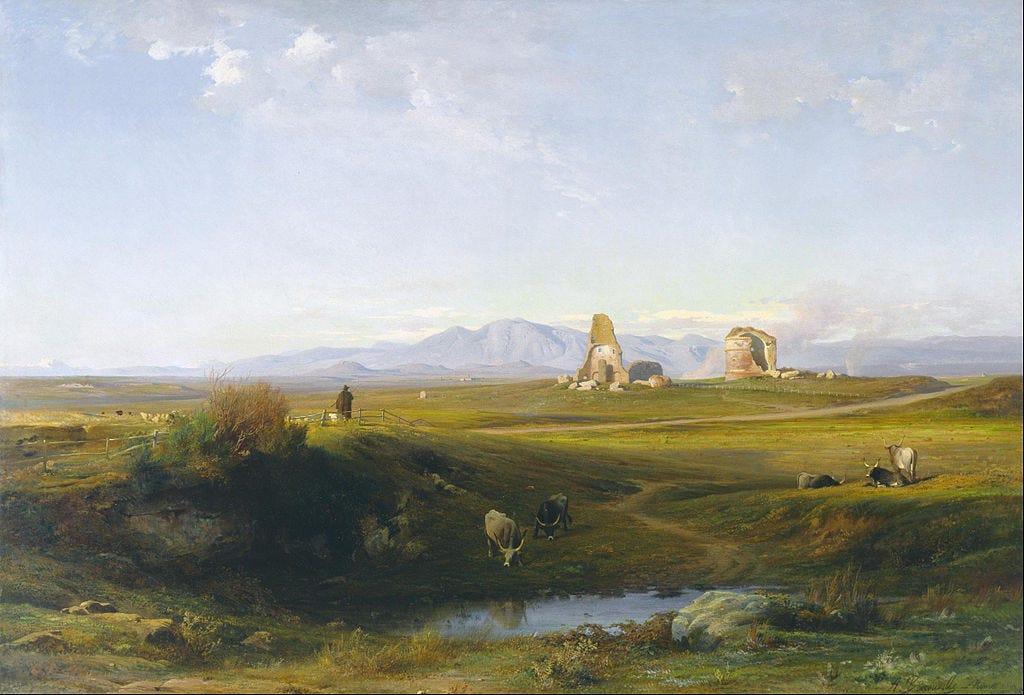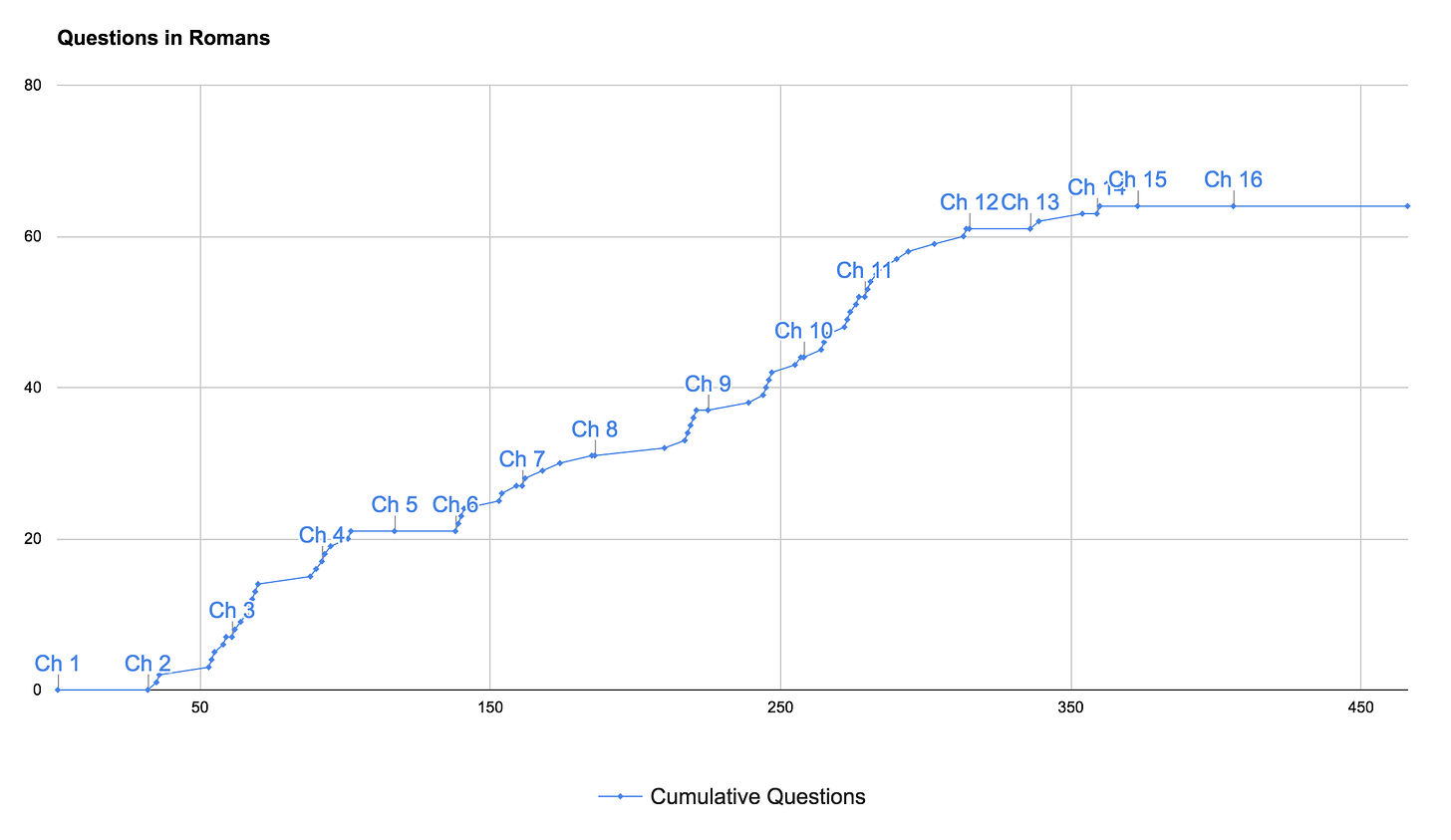A Topography of Romans
Some ad-hoc linguistic analysis of Paul's Epistle to the Romans. A throwback to the days before LLMs.
Over other works attributed to the Apostle Paul, the Epistle to The Romans is characterized by the use of rhetorical questions to advance an argument.
From soliciting introspection:
You, therefore, who teach another, do you not teach yourself?
Romans 2:21
to addressing begged counter-arguments:
What shall we say then? Is the Law sin? May it never be!
Romans 7:7
to exulting in newfound principles:
What then shall we say to these things? If God is for us, who is against us?
Romans 8:31
the author employs a Socratic method of argumentation; one where the audience must either follow or fall off.
This approach is fitting for a text so monumental; Paul’s task is no less than to establish the rationale behind his life’s work: to “bring about the obedience of faith among all the Gentiles” (Romans 1:5). Such a task requires generous amounts argumentative footwork: deconstructing preconceptions to establish novel ways of thinking. Why not employ the question mark in this venture?
A Landscape of Questions
The following image plots the frequency of question marks in the Epistle to the Romans:
The algorithm used to generate the plot is as follows. For each verse in the text, step right one unit. If a question mark (?) is present, (1) create a tick mark and (2) increment the total number of verses containing a question (step up one unit). That last step is what produces a y-axis and results in a picture with topographical features:
Rises - When a series of questions occur in a bunch, we get a sharp incline in the graph. This suggests that Paul is hard at work blazing a new trail.
Plateaus - When the graph levels out a bit due to a sparsity of questions, this suggests that Paul has achieved some new height in his argument, and may be enjoying the scenery before the next leg.
Observations
Does this picture provide any real insight as to the meaning of Romans? If the work truly employs the question mark to a significant degree, major “topographical” features should correspond to the intrinsic semantic structure of the epistle. What follows is a brief survey of such features.
Lay of the Land
Zooming way out, the epistle looks like one long incline, followed by a large plateau. In fact, the beginning of chapter 12 is a notable pivot point in the letter, where Paul shifts from mostly argument to mostly prescription and housekeeping. “Therefore I urge you, brethren, by the mercies of God…” (12:1).
Four Steppe Process
The topography shows four medium-sized plateaus, around chapters 1, 3, 5, and 8, before the final one noted above. There are certainly smaller ones to discuss, but these all surpass a threshold of at least 15 verses of question-less prose. What could be happening here?
As may be expected, chapter 1 is concerned with introductory remarks and term definitions. An effective thesis statement for the whole epistle comes halfway through the chapter: “the righteousness of God is revealed by faith” (1:17). Although Paul’s argument is well underway by the end of the chapter, the lack of rhetorical questions thus far is probably due to the audience’s familiarity with his introductory propositions.
The second plateau comes in chapter 3. Paul has worked heretofore to establish the general unrighteousness of man, and now begins to unpack the mechanism of God’s righteousness revealed by faith. Chapter 4 is a sort of case study of this very pregnant kind of faith.
By chapter 5 Paul has established justification by faith and now advances salvation by faith: “having now been justified… we shall be saved” (5:9). Chapters 6 and 7 resume the rhetorical bricklaying by systematically countering human misgivings about the possibility of actually being “made righteous” (5:19).
The final plateau in the ascent to chapter 12 occurs in chapter 8. Here Paul exults in heights of newfound spiritual truths, capturing them with a new paradigm of flesh versus spirit. This is the apex of the epistle, and quite possibly what Paul considered to be “my gospel” (2:16, 16:25)—the essence of his unique contribution to the canon.
The Final Push
What of the sharp gain from chapters 9-11? There are nearly as many questions asked in these 3 chapters as in the previous 8. The author must be particularly passionate about his subject here. In fact, this is where Paul—a “Hebrew of Hebrews” turned Christian—wrestles with the implications of his gospel for the Jewish heritage. Here’s where the question mark plot could be a bit misleading, as chapters 9-11 are easily viewed as a long, albeit energetic parenthetical and not a major development.
Conclusions
The systematic linguistic analysis of texts is an active discipline that ranges in application from authorship attribution to document classification. But these applications tend toward the extrinsic; they place a work within a larger context, but say little about its intrinsic properties. In the case of Romans, tracing the question mark provides a surprising approximation to the very rhetoric of the letter. While no substitute for doing one’s homework, this can be a refreshing approach to such a profound and well-worn text, and one often difficult to disentangle from preconceived theologies.



